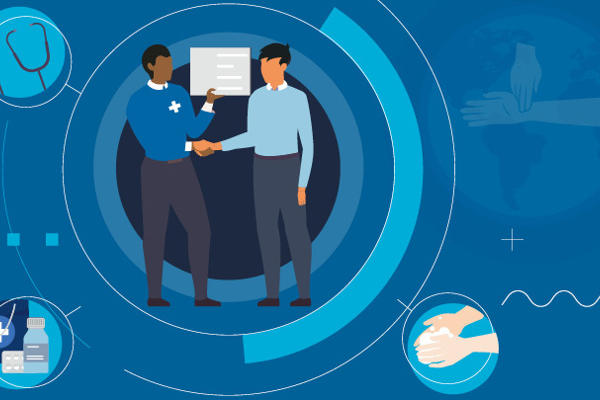Following the announcement of NHS England's Long Term Plan earlier this month, the RCP has engaged in a week-long discussion covering the plan's most important themes. In today’s blog, RCP registrar Professor Donal O'Donoghue examines the future of technology in the NHS.
The NHS Long Term Plan aims to see digitally-enabled care go mainstream across the NHS. By 2024, every patient in England will have a right to choose digital primary care from their own practice or a digital provider.
Plans for out-patient care also include digital technologies. Patients can expect to access virtual services alongside face-to-face services via computer or smartphone, with the aim of avoiding up to a third of face-to-face outpatient visits within 5 years. This responds to the ambitious overhaul that the RCP called for in our 2018 report, Outpatients: The future - adding value through sustainability, which is referenced in the plan.
The [Long Term Plan] wants this data to be useful and work across all NHS organisations, which requires a huge change in the current clinical culture
But with the NHS only set to stop using fax machines by 2020, will it be able to create the receptive environment needed for technology to really make a difference within the deadlines it sets out?
All NHS providers will digitise by 2024
All providers are expected to meet a core level of digitisation by 2024. This includes clinical and operational processes across all settings, locations and departments and, according to the plan, will be based on robust, modern IT infrastructure for storage, networks and cyber security. The roll out of Electronic Patient Record systems and, of course, associated apps will be accelerated to support this.
This is an important goal that the RCP fully supports. The plan wants this data to be useful and work across all NHS organisations, which requires a huge change in the current clinical culture. Everyone who enters and collects data needs to understand it is not just for them to use, but will be shared beyond their immediate clinical team - in other care organisations, possibly for research and the development of AI and machine learning. High quality, clean and complete data entry is crucial.
Pseudonymised data will be used to support population health management techniques and research
The plan wants population health management solutions to be deployed as soon as 2019 to help integrated care systems better understand their local populations and focus on those with greatest need. They will help identify groups of people who are at risk of adverse health outcomes and predict who is most likely to benefit from particular interventions.
The use of pseudonymised data will enable more sophisticated approaches and world-leading research, as we saw in the summer with the results of the collaboration between Deep Mind and Moorfields Eye Hospital. This is an exciting prospect, but again it depends on the availability of high-quality data, which is not yet the reality across the NHS.
Apps galore
The NHS is expected to expand its app portfolio in the near future; the plan says the NHS App will become a standard way to access information and register for services. It aims to make the app work seamlessly with other national and local services, and, where appropriate, be integrated into patient pathways. This is a huge task that must be done carefully, ensuring the app works effectively for patients in a joined-up way across all the many organisations that make up the NHS.
The plan promised that all apps commissioned and developed by the NHS will be open source so developers can build and enhance them to meet evolving needs.
The plan was weak in terms of PPI, but it did commit to working with the voluntary sector, developers and individuals to create a range of apps to support particular conditions. The successful Diabetes Prevention Program will offer digital access by 2019 and provide a model for other condition specific apps. The plan promised that all apps commissioned and developed by the NHS will be open source so developers can build and enhance them to meet evolving needs.
Of course, the NHS must ensure that all apps are safe, quick and add value to patients’ experience and the delivery of care.
Doctors will be able to see how many steps their patients take
The plan has much to say about wearable technology. Personal Health Records are getting a digital makeover and will be able to hold data from wearable devices that patients choose to share with the NHS. This means, for example, you could see how many steps your patient takes day-to-day, which could be useful for prevention, management of long-term health problems, and some data may even support diagnosis. However, like any other medical device, wearables must be tested to make sure they are safe, accurate, and the data added is not redundant but genuinely useful.
Personal Health Records will also incorporate information added by the patient themselves or their authorised carer, and ill people will increasingly be cared for in their own home, able to manage their own health with the help of digital tools. If this aspiration is achieved it will help make sure care is person-centered, tests are not repeated, and appropriate actions are taken in a timely matter.
In conclusion, to achieve what is necessary for a digital revolution in the NHS that will truly benefit patients, we need to focus as much on the people, processes and culture of the health service as on tools and techniques. The plan has many positive steps that could revolutionise care in the NHS, and the RCP looks forward to supporting rigorous evaluation so that evidence-based digital pathways can be implemented.
Professor Donal O’Donoghue is the registrar of the RCP, consultant renal physician at Salford Royal Hospital and professor of renal medicine at the University of Manchester. You can follow him on Twitter at @donalnhs.
This blog is part of a week-long series of discussions focusing on the NHS Long Term Plan. If you have any questions or feedback about the topics covered in these posts please contact policy@rcplondon.ac.uk.




